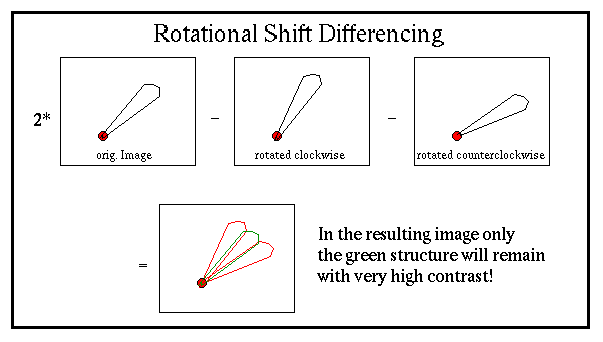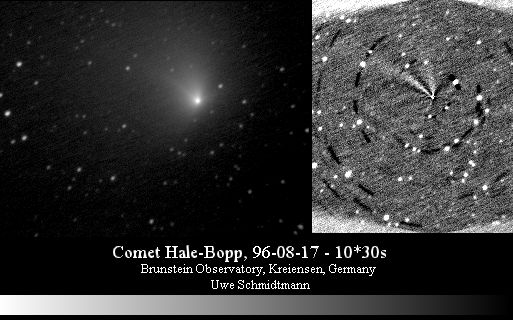Brunstein Observatory
Kreiensen, Germany
Image Processing: Rotational Shift Differencing
Rotational shift differencing has been first described by
Larson
and Sekanina. They found out that when a comet image, which has its
structures
mainly as "rays" from the center is rotated and then substracted from
the
raw image, will reveal the structures with much more contrast.
The way to do this processing is rather simple:
-
Find the centre of the comets nuclues. Therefore be sure that the image
is not overexposed!
-
Rotate the image with an angle between 7 and 15 degrees clockwise and
save
the image.
-
Rotate the image with the same angle as before, but this time
counterclockwise.
Save this image as well.
-
Multiply the original image and substract both rotated images.
The result will be an image with the comets core region in high
contrast.
The proper angle depends on the comet and the angle between the jets.
Normally
the detail will be visible with all angles between 7 and 15 degrees -
only
the contrast of the image will change. The image below illustrates the
processing:

As you can see from the image above this algorithm only works
for radial structures. It also gets less accurate with growing distance
from the nucleus of the comet. It would make sense to use an angle
depending
on the distance from the comets core but at the moment I personally
have
no idea how to program it using midas.
If you want a more smoothed image you can calculate more than
one rotated image with different angles and add the resulting images.
For
my cometary images I wrote a MIDAS script which applies the rotation
algorithm
for angles from 7 to 16 degrees with steps of one degree. All these 10
images are then added.
The following image shows an example of the comet Hale Bopp.:

Left part: logarithmically scaled image, right part: the
rotated
image. The processing of the image has been done using a Linux version
of ESO's MIDAS...
Back to the english / german index page...



